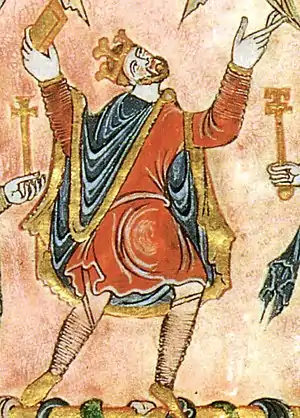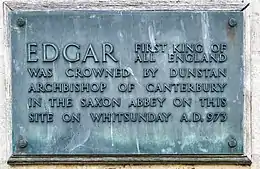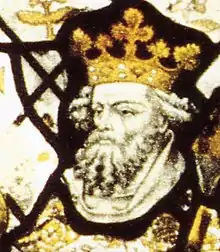Edgar, King of England
Edgar (Old English: Ēadgār [ˈæːɑdɡɑːr]; c. 943 – 8 July 975), known as the Peaceful or the Peaceable,[1] was King of the English from 959 until his death in 975. The younger son of King Edmund I and Ælfgifu of Shaftesbury, he came to the throne as a teenager following the death of his older brother, King Eadwig.[1] As king, Edgar further consolidated the political unity achieved by his predecessors, with his reign being noted for its relative stability. His most trusted advisor was Dunstan, whom he recalled from exile and made Archbishop of Canterbury. The pinnacle of Edgar's reign was his coronation at Bath in 973, which was organised by Dunstan and forms the basis for the current coronation ceremony. After his death he was succeeded by his son Edward, although the succession was disputed.
| Edgar | |
|---|---|
 Contemporary portrayal in the New Minster Charter | |
| King of the English | |
| Reign | 1 October 959 – 8 July 975 |
| Predecessor | Eadwig |
| Successor | Edward the Martyr |
| Born | 943 or 944[1] England |
| Died | 8 July 975 (aged 30–32)[1] Winchester, Hampshire, England[1] |
| Burial | Glastonbury Abbey[1] |
| Spouses | |
| Issue |
|
| House | Wessex |
| Father | Edmund I of England[1] |
| Mother | Ælfgifu of Shaftesbury |
Early years and accession
Edgar was the son of Edmund I and Ælfgifu of Shaftesbury. Upon the death of King Edmund in 946, Edgar's uncle, Eadred, ruled until 955. Eadred was succeeded by his nephew, Eadwig, Edmund's eldest son.[1]
Eadwig was not a popular king, and his reign was marked by conflict with nobles and the Church, primarily St Dunstan and Archbishop Oda. In 957, the thanes of Mercia and Northumbria changed their allegiance to Edgar.[4] A conclave of nobles declared Edgar as king of the territory north of the Thames.[5] Edgar became King of England upon Eadwig's death in October 959, aged about 16.
Government
One of Edgar's first actions was to recall Dunstan from exile and have him made Bishop of Worcester and Abbot of Glastonbury Abbey, subsequently Bishop of London and later, Archbishop of Canterbury. Dunstan remained Edgar's advisor throughout his reign.
Edgars reign is noted for the lack of conflict in comparison to his predecessors. Richard Humble has stated that this state of affairs primarily arose due to the fact Scandinavia was 'largely quiescent' during this period and Viking activity directed towards England was much reduced. While this enabled England to experience a period of stability and prosperity, it also led to a partial decay of the 'Fyrd', a levy system based around temporary military service by freemen, which reduced the Kingdoms military preparedness.[6]
The Kingdom of England was well established, and Edgar consolidated the political unity achieved by his predecessors. By the end of his reign, England was sufficiently unified that it was unlikely to regress back to a state of division among rival kingships, as it had to an extent under the reign of Eadred. William Blackstone mentions that King Edgar standardised measure throughout the realm.[7] According to George Molyneaux, Edgar's reign, "far more than the reigns of either Alfred or Æthelstan, was probably the most pivotal phase in the development of the institutional structures that were fundamental to royal rule in the eleventh-century kingdom".[8] Indeed, an early eleventh century king Cnut the Great states in a letter to his subjects that ''it is my will that all the nation, ecclesiastical and lay, shall steadfastly observe Edgar's laws, which all men have chosen and sworn at Oxford''.[9]
Benedictine reform


The Monastic Reform Movement that introduced the Benedictine Rule to England's monastic communities peaked during the era of Dunstan, Æthelwold, and Oswald (historians continue to debate the extent and significance of this movement).[10]
Dead Man's Plack
In 963, Edgar allegedly killed Ealdorman Æthelwald, his rival in love, near present-day Longparish, Hampshire.[11] The event was commemorated by the Dead Man's Plack, a stone cross erected in 1825.[11] In 1875, Edward Augustus Freeman debunked the story as a "tissue of romance" in his book, Historic Essays;[12] however, his arguments were challenged by naturalist William Henry Hudson in his 1920 book Dead Man's Plack and an Old Thorn.[5]
Coronation at Bath
Edgar was crowned at Bath and along with his wife Ælfthryth was anointed, setting a precedent for a coronation of a queen in England itself.[13] Edgar's coronation did not happen until 973, in an imperial ceremony planned not as the initiation, but as the culmination of his reign (a move that must have taken a great deal of preliminary diplomacy). This service, devised by Dunstan himself and celebrated with a poem in the Anglo-Saxon Chronicle, forms the basis of the present-day British coronation ceremony.[1]
The symbolic coronation was an important step; other kings of Britain came and gave their allegiance to Edgar shortly afterwards at Chester. Six kings in Britain, including the King of Scots and the King of Strathclyde, pledged their faith that they would be the king's liege-men on sea and land. Later chroniclers made the kings into eight, all plying the oars of Edgar's state barge on the River Dee.[14] Such embellishments may not be factual, and what actually happened is unclear.[lower-alpha 1]
Marriages and children
Edgar is known to have had 3 relationships that produced children. His first wife (or consort) was Æthelflæd Eneda (the 'white duck'), daughter of Ealdorman Ordmaer, who acquired land in Devon.[1] They married sometime before he became king, about 957. Together they had one son:
- Edward the Martyr (born c. 962 - died 978)[1][15]
Wulfthryth of Wilton, who was educated at Wilton Abbey, became his second consort. It is disputed whether they married, but Barbara Yorke argues that they did. Edgar removed Wulfthryth from Wilton Abbey, some sources say abducted, in 962 and returned her to Wilton Abbey by 964, she then took vows and became Abbess. Edgar and Wulfthryth had one daughter, who is said to have returned with her mother to the abbey:
About 964/965 Edgar married again, his third relationship, to Ælfthryth, widow of Æthelwald, Ealdorman of East Anglia, Edgar's adopted brother. Ælfthryth was the daughter of Ealdorman Ordgar and his wife, a member of the royal family of Wessex. Legend has it that Edgar heard of Ælfthryth's great beauty and sent Æthelwald to arrange marriage for him (Edgar) but Æthelwald instead married her himself. In retaliation Æthelwald was killed 'in a hunting accident' and Edgar married her as he had wanted. It is not known if this is true or simply romantic fiction. Edgar and Ælfthryth had two sons:
- Edmund Atheling (born c. 966 - died c.970)
- Æthelred the Unready (born c. 968 - d. 23 April 1016)
After the death of Edward the Martyr in 978, Æthelred was not yet old enough to rule on his own and Ælfthryth acted as regent.
Death
Edgar died on 8 July 975 at Winchester, Hampshire. He was buried at Glastonbury Abbey.[1][15] He left two sons, his successor Edward, who was probably his illegitimate son by Æthelflæd, daughter of ealdorman Ordmaer,[17] and Æthelred, the younger, the child of his wife Ælfthryth. Edgar also had a possibly illegitimate daughter by Wulfthryth, who later became abbess of Wilton. She was joined there by her daughter, Edith of Wilton, who lived there as a nun until her death. Both women were later regarded as saints.[16][18]
Veneration
Edgar the Peaceful | |
|---|---|
 Stained glass window, All Souls College Chapel, Oxford | |
| King of England | |
| Honored in | Catholic Church Eastern Orthodox Church |
| Feast | July 8 |
| Patronage | Kings and Widowers[19] |
Edgar the Peaceful is venerated[20] in Catholic Church[21][22] and Eastern Orthodox Church[23] on July 8.[24]
See also
- House of Wessex family tree
References
Notes
- Jayakumar 2008, p. 121 states, "Precisely what happened at Chester has been irretrievably obscured by the embellishments of twelfth-century historians."
Citations
- Weir 2008, p. 20.
- Stafford 2001, pp. 324–325.
- Stafford 2001, p. 91.
- ""Edgar the Peaceful (c. 943–975) – King of England", BBC, January 13, 2005". Archived from the original on April 12, 2020. Retrieved January 26, 2014.
- Hudson 1920.
- Humble 1983, pp. 110–114.
- "Blackstone, "Of the King's Prerogative" Bk. 1, Ch. 7". Archived from the original on 2007-08-10.
- Molyneaux 2015, p. 193.
- Trow 2007, pp. 168–169.
- Lehmberg 2013, p. 29.
- "Deadman's Plack Monument – Longparish – Hampshire – England". British Listed Buildings. Retrieved 8 September 2011.
- Freeman 1875, pp. 10–25.
- Huneycutt 2003, p. 35.
- Huscroft 2013, p. 21.
- Hart 2007.
- Yorke 2004.
- Fisher 1952, pp. 254–270.
- Williams 2004.
- "Saint Edgar the Peaceful - Saint of the Day - July 8". Catholic Daily Readings. 2019-07-01. Retrieved 2021-07-30.
- "Saint Edgar "the Peaceful"". Aleteia — Catholic Spirituality, Lifestyle, World News, and Culture. Retrieved 2021-07-30.
- Online, Catholic. "St. Edgar the Peaceful - Saints & Angels". Catholic Online. Retrieved 2021-07-30.
- "Saint Edgar the Peaceful". CatholicSaints.Info. 2009-11-26. Retrieved 2021-07-30.
- "Latin Saints of the Orthodox Patriarchate of Rome". www.orthodoxengland.org.uk. Retrieved 2021-07-30.
- ".:ILG:. - Czytelnia: 8 lipca - sw. Edgar Spokojny". www.brewiarz.katolik.pl. Archived from the original on 2007-11-05. Retrieved 2021-07-30.
Sources
- Fisher, D. J. V. (1952). "II. The Anti-Monastic Reaction in the Reign of Edward the Martyr". Cambridge Historical Journal. Cambridge University Press. 10 (3): 254–270. doi:10.1017/s147469130000295x. ISSN 1474-6913.
- Freeman, Edward Augustus (1875). Historic Essays. MacMillan & Co.
- Hart, Cyril (2007). "Edward [St Edward; called Edward the Martyr] (c. 962–978)". Oxford Dictionary of National Biography (online ed.). Oxford University Press. doi:10.1093/ref:odnb/8515. (Subscription or UK public library membership required.)
- Huneycutt, L.L. (2003). Matilda of Scotland: A Study in Medieval Queenship. Anglo-norman studies. Boydell Press. ISBN 978-0-85115-994-2.
- Hudson, William Henry (1920). Dead Man's Plack and An Old Thorn. London and Toronto: J.M. Dent and Sons.
- Humble, R. (1983). The Saxon Kings.
- Huscroft, R. (2013). The Norman Conquest: A New Introduction. Taylor & Francis. ISBN 978-1-317-86627-5.
- Jayakumar, Shashi (2008). "Eadwig and Edgar: Politics, Propaganda and Faction". In Donald Scragg (ed.). Edgar, King of the English, 959-975: New Interpretations. Publications of the Manchester Centre for Anglo-Saxon Studies. Boydell Press. ISBN 978-1-84383-399-4.
- Lehmberg, S. (2013). A History of the Peoples of the British Isles: From Prehistoric Times to 1688. Taylor & Francis. ISBN 978-1-134-41528-1.
- Molyneaux, G. (2015). The Formation of the English Kingdom in the Tenth Century. Oxford University Press. ISBN 978-0-19-871791-1.
- Stafford, P. (2001). Queen Emma and Queen Edith: Queenship and Women's Power in Eleventh-Century England. Wiley. ISBN 978-0-631-22738-0.
- Trow, M.J. (2007). Cnut: Emperor of the North. Sutton Series. History Press Limited. ISBN 978-0-7509-3401-5.
- Weir, A. (2008). Britain's Royal Families: The Complete Genealogy. Vintage. ISBN 978-0-09-953973-5.
- Williams, Ann (2004). "Edgar (called Edgar Pacificus) (943/4–975)". Oxford Dictionary of National Biography (online ed.). Oxford University Press. doi:10.1093/ref:odnb/8463. (Subscription or UK public library membership required.)
- Yorke, Barbara (2004). "Wulfthryth (St Wulfthryth) (d. c.1000), abbess of Wilton". Oxford Dictionary of National Biography (online ed.). Oxford University Press. doi:10.1093/ref:odnb/49423. (Subscription or UK public library membership required.)
Further reading
- Keynes, Simon (1999). "England, c. 900–1016". In Timothy Reuter (ed.). The New Cambridge Medieval History III. c.900–c.1024. Cambridge: University Press. pp. 456–84.
- Rex, Peter (2007). Edgar, King of the English 959-75. Stroud, Gloucestershire: Tempus.
- Sobecki, Sebastian (2011). "Edgar's Archipelago". In Sebastian Sobecki (ed.). The Sea and Englishness in the Middle Ages: Maritime Narratives, Identity and Culture. Cambridge: Brewer. pp. 1–30. ISBN 978-1-84384-276-7.
External links
- Edgar 11 at Prosopography of Anglo-Saxon England
- Medieval Sourcebook: Anglo-Saxon Dooms: laws of King Edgar, a fragment
- Edgar, King of England at Find a Grave
